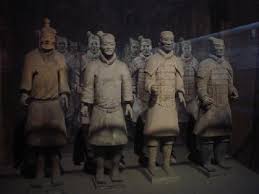
The Terracotta Army: The Eighth Wonder of the World?
The Terracotta Army, an awe-inspiring collection of life-sized terracotta sculptures depicting the armies of Qin Shi Huang, the first emperor of China, is often hailed as the "Eighth Wonder of the World." However, when compared to the grandeur and mystery of the Qin Shi Huang Mausoleum, of which the Terracotta Army is just a small part, it becomes clear that this title merely scratches the surface of its true significance.
A Glimpse into an Imperial Afterlife: The Terracotta Army
Unearthed in 1974 by farmers digging a well, the Terracotta Army has captivated the world with its sheer scale and intricate craftsmanship. Located approximately 1.5 kilometers east of the emperor's tomb mound, the army consists of over 8,000 life-sized warriors, chariots, and horses, each meticulously crafted with unique facial features, hairstyles, and armor.
The sheer scale of the Terracotta Army reflects the ambition of Qin Shi Huang, who unified China in 221 BC. He envisioned an afterlife mirroring his earthly reign, complete with a vast army to protect him in the afterlife. The discovery of the army has provided invaluable insights into the military organization, weaponry, and cultural practices of the Qin Dynasty.
The Emperor's Tomb: A Universe Yet to Be Uncovered
While the Terracotta Army is a sight to behold, it represents merely a fraction of the vast necropolis that is the Qin Shi Huang Mausoleum. The tomb itself, a colossal pyramid-shaped mound covering an area of 56.25 square kilometers, remains largely unexplored.
Historical records, such as the writings of the ancient historian Sima Qian, describe the tomb as containing a microcosm of the emperor's empire, with ceilings depicting celestial constellations and the floor modeled after the geography of China. Rivers of mercury are said to flow within, symbolizing the great rivers of China.
A World Heritage Site: Protecting a Legacy
Recognizing the immense historical and cultural significance of the Qin Shi Huang Mausoleum, UNESCO designated it a World Heritage Site in 1987. The official certificate was presented on July 25th, 1991, in Beijing, signifying the site's entry into an era of international protection and conservation.
The Chinese government has undertaken extensive efforts to preserve the Terracotta Army and study the mausoleum complex. However, the sheer scale of the tomb and the complexity of its construction, coupled with the desire to preserve its contents for future generations using advanced technology, have made excavation a delicate and gradual process.
A Legacy Shrouded in Mystery
The Qin Shi Huang Mausoleum, with its enigmatic tomb and the awe-inspiring Terracotta Army, stands as a testament to the power and ambition of one of China's most influential rulers. While the Terracotta Army offers a glimpse into the military might of the Qin Dynasty, the unexplored tomb holds within its depths countless secrets and treasures, promising to unlock even more profound insights into ancient China as technology advances.
Q&A
Q: What is the significance of the Terracotta Army?
A: The Terracotta Army is significant for several reasons. Firstly, its sheer scale is impressive, demonstrating the power and ambition of Qin Shi Huang. Secondly, each figure is unique, providing invaluable insights into the military practices, armor, hairstyles, and even the ethnic diversity of the Qin Dynasty.
Q: Why hasn't the main tomb of Qin Shi Huang been fully excavated?
A: There are several reasons why the main tomb remains largely unexplored. Primarily, the Chinese government aims to preserve the tomb's contents for future generations. Current technology may not be sufficient to excavate the tomb without damaging the delicate artifacts within. Additionally, concerns about high levels of mercury mentioned in historical texts contribute to the cautious approach.
Q: What can we learn from further exploration of the Qin Shi Huang Mausoleum?
A: Further exploration of the mausoleum promises to unveil a wealth of knowledge about the Qin Dynasty, from architectural techniques and burial practices to insights into the emperor's beliefs about the afterlife and the cosmology of the time. It may also yield invaluable artifacts that could shed light on daily life, art, and technology during that era.